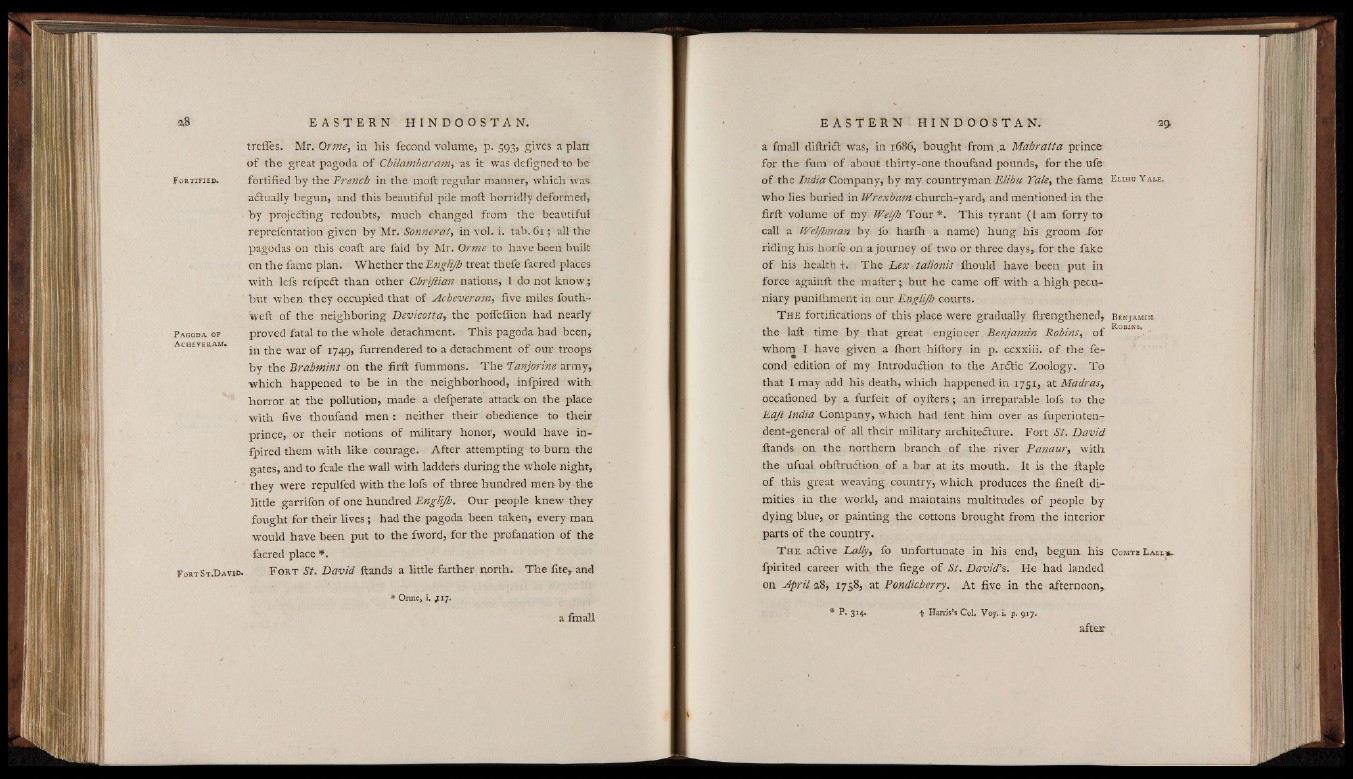
F ortifies*.
P agoda of
A cheveram*
F ort St .D a v id .
trefies. Mr. Orme, in his fecond volume, p. 593, gives a plan
of the great pagoda of Chilambaram, as it was defigned to be-
fortified by the French in the molt regular manner, which was.
aétually begun, and this beautiful pilé moil horridly deformed,
by projecting redoubts, much changed from the beautiful
reprefentation given by Mr. Sonnerat, in vol. i. tab. 61; all the
pagodas on this coaft are faid by Mr. Orme to have been built
on the fame plan. Whether the Englijh treat thefe facred places
with lefs refpcft than other Cbriftian nations, I do not know;
hut when they occupied that of Acheveram, five miles fouth-
weft of the neighboring Devicotta, the poffeffion had nearly
proved fatal to the whole detachment. This pagoda had been,
in the war of 1749, furrendered to a detachment o f our troops
by the Brahmins on the firft fummons. The Tanjorine army,
which happened to be in the neighborhood, infpired with
horror at the pollution, made a defperate attack on the place
with five thoufand men 1 neither their obedience to their
prince, or their notions of military honor, would have infpired
them with like courage. After attempting to burn the
gates, and to fcale the wall with ladders during the whole night,
they were repulfed with the lofs o f three hundred men by the
little garrifon o f one hundred Engii/h. Our people knew they
fought for their lives; had the pagoda been taken, every man
would have been put to the fword, for the profanation of the
facred place *.
F o r t St. David ftands a little farther north. The fite, and
* Orme, i. f 17.
a final).
a fmall diftridt was, in 1686, bought from .a Mahratta prince
for the fum o f about thirty-one thoufand pounds, for the ufe
of the India Company, by my countryman 'Elibu Tale, the fame E lihu Y a l e .
who lies buried in Wrexham church-yard, and mentioned in the
firft volume of my Weiß Tour*. This tyrant (l am forry to
call a Welfiman by fo harih a name) hung his groom Tor
riding his horie on a journey of two or three days, for the fake
o f his health t. The Lex talionis ihould have been put in
force againft the mailer; but he came off with a high pecuniary
punifliment in our Engli/h courts.
T h e fortifications o f this place were gradually ftrengthened, B enjami»
the laft time by that great engineer Benjamin Robins, of Robins\ j
whom I have given a ihort hiftory in p. ccxxiii. o f the fecond
edition of my Introduction to. the Arctic Zoology. To
that I may add his death, which happened in 1751, at Madras,
occafioned by a furfeit o f oyiters; an irreparable lofs to the
Laft India Company, which had fent him over as fuperinten-
dent-general of all their military architeilure. Fort St. David
ftands on the northern branch o f the river Panaur, with
the ufuai ohftrudlion o f a bar at its mouth. It is the ftaple
of this great weaving country, which produces the fineft dimities
in the world, and maintains multitudes o f people by
dying blue, or painting the cottons brought from the interior
parts of the country.
T h e . active Lally, fo unfortunate in his end, begun his C omte L a l l * .
fpirited career with the fiege of St. David's. He had landed
on April 28, 1738, at Pondicherry. At five in the afternoon,
* P. 314.. f Harris’s Col. Voy..i, p. 917.
after